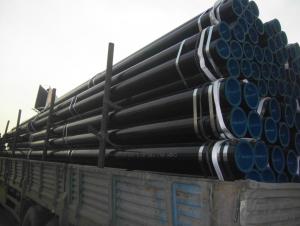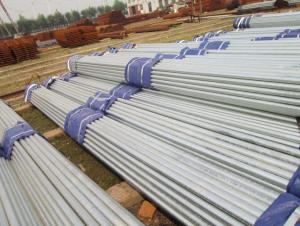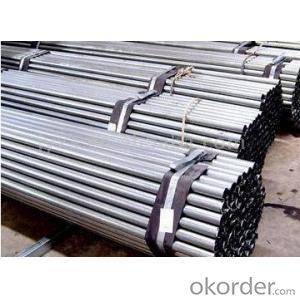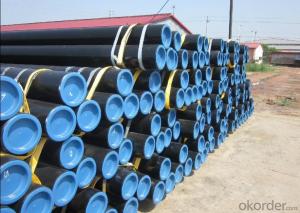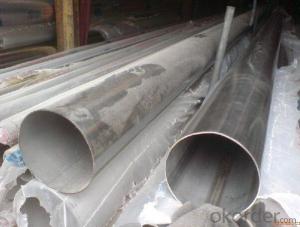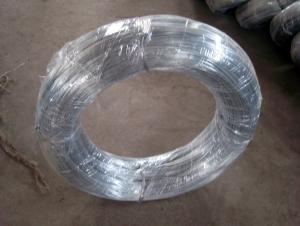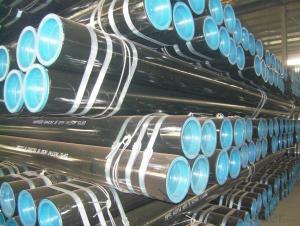SEAMLESS PIPE WITH BLACK PAINTING
- Loading Port:
- China Main Port
- Payment Terms:
- TT OR LC
- Min Order Qty:
- -
- Supply Capability:
- -
OKorder Service Pledge
OKorder Financial Service
You Might Also Like
Product Description
1. Commodity Name: Carbon Seamless steel pipe
2. Standard: API,GB,ASTM,ASME,DIN
3. Quality grade: 10#, 20#, A106B, A53B, API 5L B, Q235, Q345, ST37-2, ST 45, ST52.etc.
4. Dimension:
OD: 1/2"-24"
WT: 2.5-80mm, SCH10~SCH40~XXL
length: 5.8m,6m,8m,9m,12m
5. Technique: Hot Rolled/Cold Rolled/ Cold Drawn
6. application
carbon seamless steel pipes are widely used in gas, water and oil, transpotation;constructions;Bridge,highway,windows of model steel door; building materials;fences;heating facilities Fluid Pipe;conduit pipe,scaffolding pipe.etc.
7. Payment Terms: L/C D/A D/P T/T
8.packing and shipment
Packaged in bundles,as per customers' requirements, it can also bepackagesd as beveled ends, typed marking, black painting, plastic caps protection,woven bags packing
For 20" container the max length is 5.8m; For 40" container the max length is 12m. other options are available based on customer requests. Please discuss when placing orders.
- Q: Can steel pipes be used for chemical refineries?
- Yes, steel pipes can be used for chemical refineries. Steel pipes are commonly used in chemical industries due to their high strength, durability, and resistance to corrosion. They can withstand high pressure and temperature conditions, making them suitable for transporting various chemicals and fluids within a refinery. Additionally, steel pipes can be easily welded, ensuring a secure and leak-proof system in chemical refineries.
- Q: How are steel pipes used in the construction of shipbuilding?
- Steel pipes are widely used in shipbuilding as they provide structural support and are essential for various systems and components such as ventilation, fuel, and water supply. They are used to create the framework of the ship, including the hull, bulkheads, and decks. Additionally, steel pipes are crucial for piping systems that transport fluids and gases throughout the ship, ensuring its proper functioning and safety.
- Q: How are steel pipes classified according to their wall thickness?
- Steel pipes are classified according to their wall thickness into three categories: schedule, standard, and extra strong.
- Q: How are steel pipes inspected for defects?
- Steel pipes are typically inspected for defects using various non-destructive testing methods such as ultrasonic testing, magnetic particle inspection, and visual inspection. These techniques help identify any cracks, corrosion, or other defects in the pipes, ensuring their structural integrity and quality.
- Q: How are steel pipes used in offshore drilling platforms?
- Steel pipes are used in offshore drilling platforms to transport drilling fluids, such as mud and cement, from the drilling rig to the wellbore. These pipes are also used to extract oil and gas from the well by connecting the drilling rig to the subsea wellhead. Additionally, steel pipes provide structural support and stability to the drilling platform, ensuring safe and efficient operations in harsh offshore environments.
- Q: Can steel pipes be used for wastewater treatment plants?
- Yes, steel pipes can be used for wastewater treatment plants. Steel pipes are commonly used in wastewater treatment plants due to their durability, strength, and resistance to corrosion. They are suitable for conveying and transporting various types of wastewater and can withstand the harsh and corrosive environment found in these facilities. Additionally, steel pipes can be easily welded and joined, allowing for efficient installation and maintenance processes.
- Q: What are the different methods of pipe repair for steel pipes?
- When it comes to repairing steel pipes, there are several methods available that depend on the severity and location of the damage. Below, you will find a list of the most common methods used: 1. Welding: This method is frequently employed for fixing steel pipes, particularly when the damage is confined to a specific area. To execute this repair, the damaged portion of the pipe is removed and replaced with a new piece that is welded securely. Afterwards, the weld is thoroughly inspected to verify its strength and reliability. 2. Pipe wrapping: This approach entails wrapping a layer of fiberglass or epoxy tightly around the damaged section of the pipe. This wrap provides structural reinforcement and effectively prevents further leakage or corrosion. 3. Pipe lining: This technique involves inserting a flexible liner into the damaged pipe. The liner is typically composed of materials such as epoxy, PVC, or cured-in-place pipe (CIPP). Once inserted, the liner is either inflated or heated to conform to the shape of the pipe, creating a new inner surface that is resistant to corrosion and leakage. 4. Slip lining: Similar to pipe lining, slip lining involves placing a smaller diameter pipe inside the damaged one. The smaller pipe acts as a protective sleeve, reinforcing the structure and preventing further deterioration of the original pipe. 5. Pipe bursting: This method is utilized when the damage to the pipe is extensive. A new pipe is pulled through the damaged one using a hydraulic or pneumatic system. As the new pipe is pulled through, it bursts the old pipe, resulting in a larger diameter pipe with minimal disturbance to the surrounding area. 6. Clamp or sleeve repair: In cases where the damage is small and localized, a clamp or sleeve can be applied to temporarily or permanently fix the issue. The clamp or sleeve is placed securely over the damaged section to prevent leakage. It is important to keep in mind that the optimal method for repairing steel pipes depends on factors like the extent of damage, accessibility, cost, and structural requirements. It is recommended to consult with a professional pipe repair specialist or engineer to determine the most suitable method for your specific situation.
- Q: How do you repair a damaged steel pipe?
- To repair a damaged steel pipe, the first step is to identify the extent of the damage. If the damage is minor, it can be fixed using a pipe repair clamp or a stainless-steel wrap. For larger damages, a cut and replace method may be necessary, where the damaged section is cut out and replaced with a new piece of pipe. In some cases, welding or soldering techniques may be required. It is important to consult with a professional plumber or pipe repair specialist to ensure the correct repair method is used for the specific situation.
- Q: The plastic pipe and steel pipe difference
- In fact, including the steel plastic pipe plastic pipe, but on the market all the steel plastic pipe and plastic lining steel pipe is synonymous, lined with plastic pipe is made of galvanized steel pipe internal set of plastic pipe manufacturing process, process using high pressure steam to both adhesion.
- Q: What are the different testing methods used for steel pipes?
- There are several testing methods used for steel pipes to ensure their quality and reliability. Some of the commonly used testing methods include: 1. Non-destructive Testing (NDT): NDT methods such as ultrasonic testing, magnetic particle inspection, and liquid penetrant testing are used to detect any surface or subsurface defects in the steel pipes without causing any damage to them. 2. Mechanical Testing: Mechanical testing involves conducting various tests to evaluate the mechanical properties of steel pipes, including tensile strength, yield strength, elongation, hardness, and impact resistance. These tests help determine the structural integrity and performance of the pipes. 3. Hydrostatic Testing: This method involves subjecting the steel pipes to high-pressure water to check their ability to withstand the expected operating conditions. Hydrostatic testing is performed by filling the pipes with water and pressurizing them to a predetermined level for a specified duration. Any leakage or deformation in the pipes is detected during this test. 4. Dimensional Inspection: This testing method ensures that the steel pipes meet the specified dimensional requirements. It involves measuring the diameter, wall thickness, length, and other critical dimensions of the pipes to verify compliance with the applicable standards or specifications. 5. Visual Inspection: Visual inspection is a basic method used to assess the external appearance of steel pipes. Trained inspectors visually examine the pipes for any surface defects, such as cracks, corrosion, or irregularities in shape or finish. 6. Chemical Analysis: Chemical analysis is performed to determine the composition and elemental content of the steel pipes. It helps ensure that the pipes are made from the correct grade of steel and meet the required chemical composition standards. 7. Metallographic Examination: Metallography involves examining the microstructure of steel pipes under a microscope to assess their quality and integrity. It helps identify any internal defects, such as grain boundaries, inclusions, or improper heat treatment, that may affect the overall performance of the pipes. By utilizing these testing methods, manufacturers and inspectors can ensure that steel pipes meet the necessary quality standards and are suitable for their intended applications.
Send your message to us
SEAMLESS PIPE WITH BLACK PAINTING
- Loading Port:
- China Main Port
- Payment Terms:
- TT OR LC
- Min Order Qty:
- -
- Supply Capability:
- -
OKorder Service Pledge
OKorder Financial Service
Similar products
Hot products
Hot Searches
Related keywords
